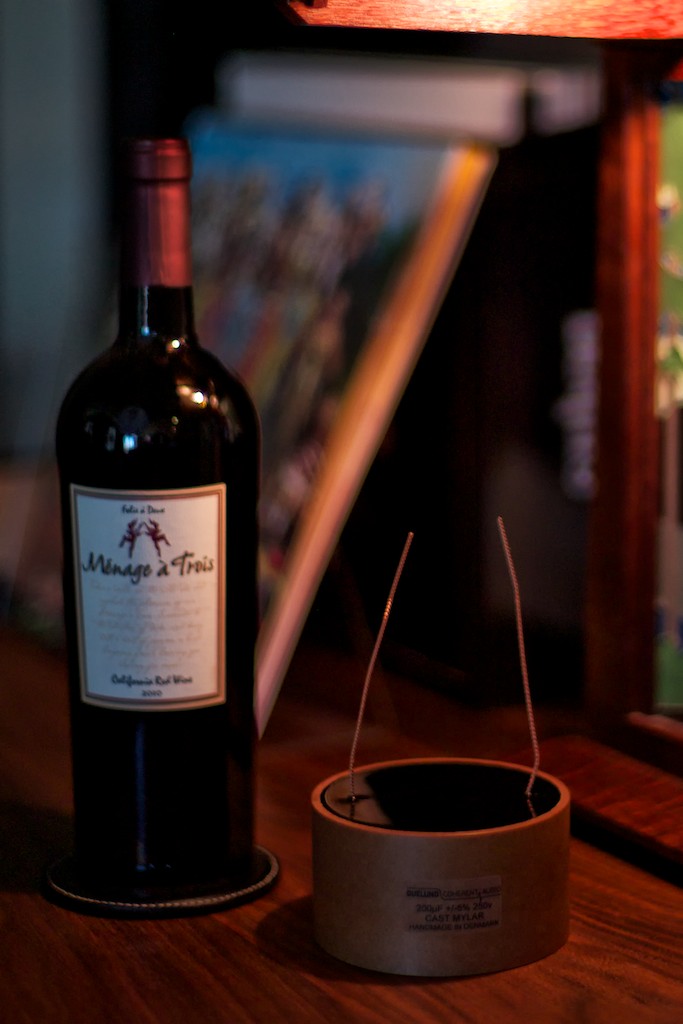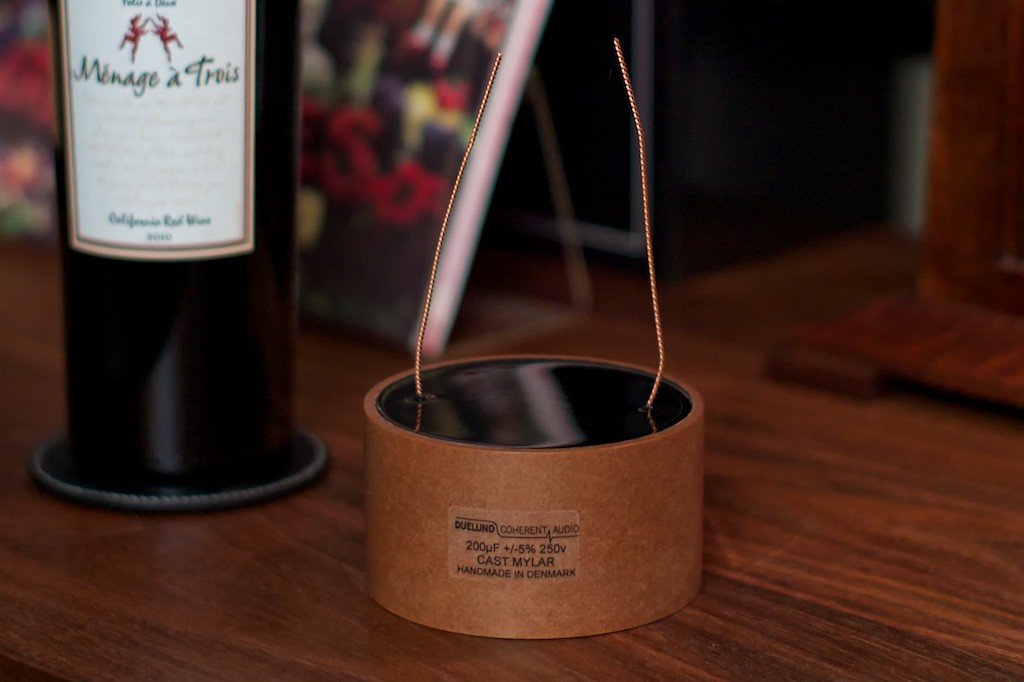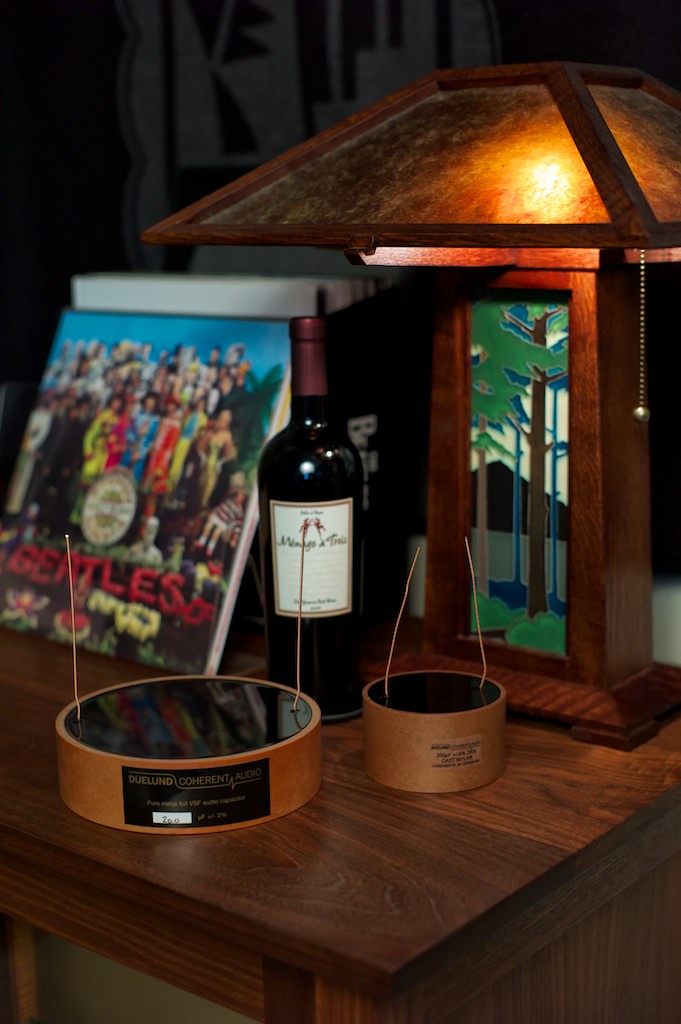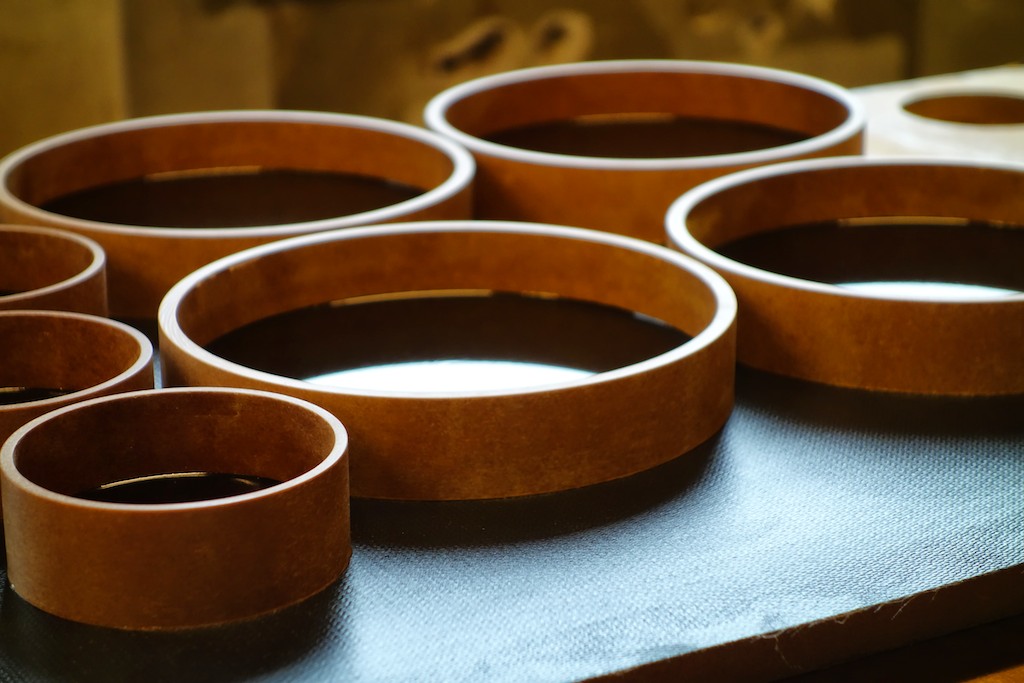Today's Fresh Catch is the new Duelund Coherent Audio CAST Mylar Capacitor.
For those of you who have been following the developments of the Duelund-WRSE Project, where we are building custom outboard crossovers for the Tannoy Westminster Royal SE loudspeakers using the state-of-art Duelund Coherent Audio CAST components, you know that Frederik Carøe created a new Duelund CAST Mylar capacitor for use in the C4 position in the low-frequency section of the crossover (see schematic below). It's actually quite an amazing story I think, so I wanted to share it with you.
Normally Mr. Steen Aa. Duelund and Frederik Carøe would have eschewed the use of a non-natural material like Mylar in one of their Duelund CAST capacitors, instead preferring only pure annealed soft copper or silver foil in natural paper and oil.
If you look at the 20 uF Duelund CAST copper foil paper-in-oil capacitor to the left in the photo below, and then compare it to the size of the wine bottle placed just behind it as a size reference, you can see that the 20 uF capacitor is the size of a cheese wheel, or a cheesecake ... or ... whatever your reference is, its huge!
Now that's a 20 uF Duelund CAST copper foil paper-in-oil capacitor, so now imagine if you scaled it up to a 200 uF Duelund CAST copper foil paper-in-oil capacitor how big it would be! It would be the size of a wine barrel! (and as expensive as an automobile!) So clearly that's not a realistic option to use in a loudspeaker crossover.
Originally Frederik had suggested we just use the stock 200 uF capacitor from the Tannoy low-frequency crossover board in the C4 position, but the more Frederik thought about it, the challenge of creating a Duelund 200 uF capacitor of manageable size to use in the C4 position became irresistible!
Update: Frederik just sent me a photo of some 150 uF Duelund CAST copper foil paper-in-oil capacitors that he made up (below). Look at the size of them compared to the tea/coffee cup in the photo! Now imagine the even bigger size of 200 uF Duelund CAST capacitors!
So Frederik set to work, and after considering his options, he decided to try using a metalized mylar foil with the same construction techniques as he uses for the premium CAST copper and silver capacitors. Frederik told me, "The CAST Mylar capacitor is made from four separate Mylar windings. We found that to be the best compromise when size and cost are an issue. The windings are connected to create one 200uF capacitor. The use of CAST dampening cancels out a lot of typical illnesses in such a design, and we are happy to see them tried in your Westminsters."
 As you can see in the photo above, the 200 uF Duelund CAST Mylar capacitor is still a big capacitor, being bigger around than a wine bottle, and of substantial height!
As you can see in the photo above, the 200 uF Duelund CAST Mylar capacitor is still a big capacitor, being bigger around than a wine bottle, and of substantial height!
As with the Duelund CAST copper & silver paper-in-oil capacitors, each Duelund CAST Mylar capacitor is made completely by hand in an incredibly labor intensive process. The Mylar foil is wound initially by machine, and then by hand in a humidity and temperature-controlled room to an exact specification. Immediately after this the winding is sealed by the use of a special lacquer, which Frederik says is also used in the yacht industry to seal out moisture. This takes another week. During this process a ring of vacuum impregnated paper has been readied with a base of our CAST material.
The sealed Mylar winding is then heated and placed in the ring & base assembly, and then as Frederik mentioned in a previous post, "The CAST material is poured on top of it in five stages, with air bubbles in the CAST material being forced out by applying a very precisely controlled flame to the surface. This process takes another week. Following this step the capacitor is measured and checked (as it has been at every step along the way), and if everything is ok, then we ship it to the customer." Total production time to hand-craft the Duelund CAST capacitors is "typically six to eight weeks” says Frederik.
So when all is said and done you have a work of electronic art in the 200 uF Duelund CAST Mylar capacitor, and I feel honored that we're going to be able to take it on its maiden voyage in the Duelund-WRSE Project.
 So now every single component in the crossover - save the Tannoy autoformer in the high-frequency section - is a state-of-art Duelund CAST component - I'm excited!
So now every single component in the crossover - save the Tannoy autoformer in the high-frequency section - is a state-of-art Duelund CAST component - I'm excited!
Stay tuned for more, and thanks for stopping by!

































